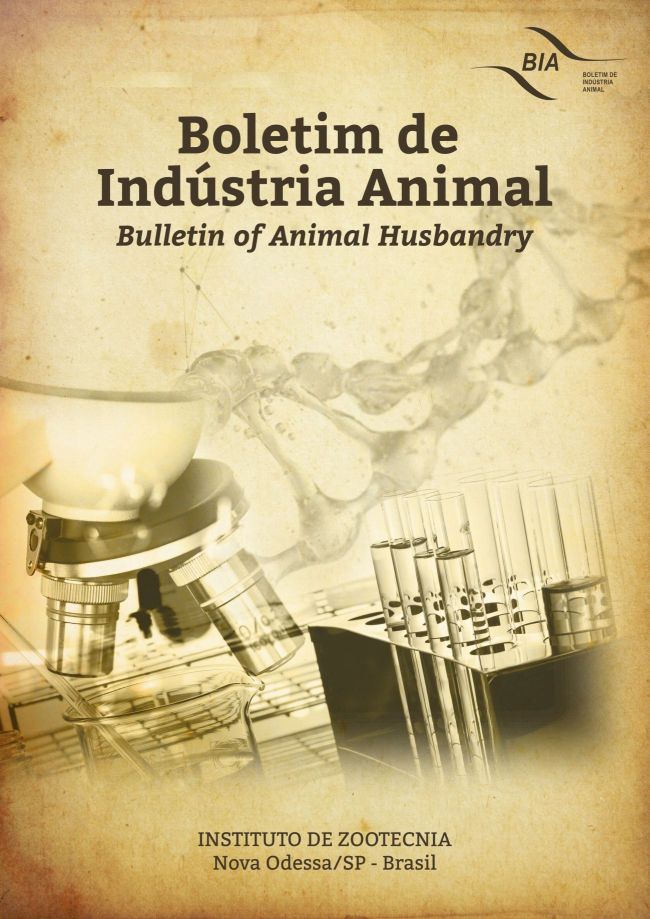Fermentation characteristics, chemical composition and fractionation of Gliricidia silage protein submitted to different fermentation periods
DOI:
https://doi.org/10.17523/bia.2019.v76.e1436Keywords:
: canned forage; Gliricidia sepium; protein fractions; quality of silageAbstract
The objective of this study was to evaluate the effect of the fermentation time on the qualitative and chemical characteristics of Gliricidia sepium silage grown in the sergipe agreste. A completely randomized experimental design with five treatments and six replicates was used. The treatments were the different opening periods of the silos (7, 14, 30, 42 and 60 days after the closing date). PVC minisilars with 10 cm diameter and 30 cm length were used. The production of lactic acid was influenced (P = 0.01) of the fermentation time, presenting a quadratic positive behavior. The buffer capacity showed a linear behavior (P = 0.02) along the fermentation time. Negative quadratic behavior (P = 0.01) was observed for pH values, as a function of fermentation time. Positive quadratic behavior (P <0.01) was observed on ammoniacal silage. There was a positive quadratic effect (P = 0.04) on the EE concentration during the fermentation times analyzed, there was no effect (P> 0.05) of the fermentation time for the other chemical variables with mean values €‹€‹of 230.2 g / kg, 66.4; 514.8; 407.6; 66.7; 107.2; 447.4 and 213.4 (g / kg DM) for MS, MM, NDF, ADF, Lig, Hem, Cel and NFC respectively. No effect (P> 0.05) of the fermentation time was observed for the crude protein (CP) content and the fractionation protein values €‹€‹with mean values €‹€‹of 204.2 g / kg, 356.2, 128.8, 353, 162.6, for PB, fraction A, fraction B1 + B2, fraction B3 and fraction C, respectively. Gliricidia demonstrated potential as a food source in the form of silage, as the fermentation retained its bromatological characteristics and is suitable for consumption of the animals at 60 days of fermentation.
Downloads
Downloads
Published
Issue
Section
License
Os autores não serão remunerados pela publicação de trabalhos, pois devem abrir mão de seus direitos autorais em favor deste periódico. Por outro lado, os autores ficam autorizados a publicar seus artigos, simultaneamente, em repositórios da instituição de sua origem, desde que citada a fonte da publicação original seja Boletim de Indústria Animal. A revista se reserva o direito de efetuar, nos originais, alterações de ordem normativa, ortográfica e gramatical, com vistas a manter o padrão culto da língua e a credibilidade do veículo. Respeitará, no entanto, o estilo de escrever dos autores. Alterações, correções ou sugestões de ordem conceitual serão encaminhadas aos autores, quando necessário. Nesses casos, os artigos, depois de adequados, deverão ser submetidos a nova apreciação. As opiniões emitidas pelos autores dos artigos são de sua exclusiva responsabilidade. Todo o conteúdo deste periódico, exceto onde está identificado, está licenciado sob a Licença Creative Commons Attribution (CC-BY-NC). A condição BY implica que os licenciados podem copiar, distribuir, exibir e executar a obra e fazer trabalhos derivados com base em que só se dão o autor ou licenciante os créditos na forma especificada por estes. A cláusula NC significa que os licenciados podem copiar, distribuir, exibir e executar a obra e fazer trabalhos derivados com base apenas para fins não comerciais.













